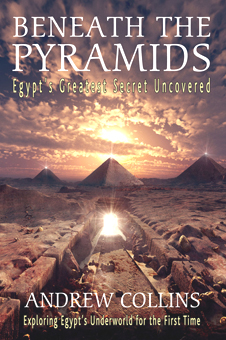
B
E N E A T H
T H E
P
Y R A M I D S
EGYPT'S
GREATEST SECRET REVEALED?
To
buy BENEATH THE PYRAMIDS, Andrew's new book on the quest to find Giza's cave underworld,
from Amazon click here.
To
buy straight from the publisher, 4th Dimension Press, click here.
Secure
BENEATH THE PYRAMIDS signed, direct from the author by clicking
here
A
Comprehensive Introduction to Andrew Collins's
new book released in September
2009
1. THE LOST CATACOMBS
In
1817, Sir Henry Salt, British Counsel General to Egypt, along with the maverick
Italian explorer Giovanni Caviglia, explored a spacious tomb west of the Great
Pyramid. It was part of a systematic investigation of Giza's famous necropolis
in their unerring bid to find, and convey back to their own countries, antiquities
and treasures of every kind, whether of commercial or philological value.
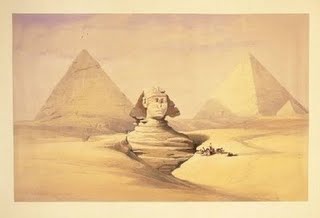 The Sphinx as drawn by the Italian explorer Giovanni Caviglia in 1817. | After exploring a crack in the rock, Salt and Caviglia unexpectedly found themselves peering inside a chasm-like chamber, partly hewn, partly natural, which opened up into a maze of subterranean passages. After traveling for a distance of some several hundred yards, the two men chanced upon a spacious chamber that linked to three other chambers of equal size, from which went various 'labyrinthick' passages. Salt left Caviglia to explore one of them, he having become bored by these empty corridors and chambers. The Italian followed one for a distance of 300 feet before giving up, having found no obvious antiquities. |
Only one allusion to Salt and Caviglia's discoveries was ever published, and this was in J.J.Hall's "Life and Correspondence of Henry Salt" (1834). Page 92 states: "The next undertaking of Caviglia was to examine So what exactly had Salt and Caviglia found, and why is their account so important? |
|
Ever
since the age of the Pharaohs Egyptian myths and legends had alluded to a cave
underworld at Giza. Such stories were told by Roman and Arab travelers to Egypt,
and even by those who inhabit the settlements and villages closest to the plateau.
In
more modern times psychics and mystics such as America's 'sleeping prophet' Edgar
Cayce (1877-1945) have revived the search for what has become known as the Hall
of Records, an underground library said to contain the lost arts and treasures
of an antediluvian civilization. In the last 50 years several expeditions, almost
all of them funded by the Association for Research and Enlightenment (ARE), the
active wing of the Edgar Cayce Foundation, have attempted without success to locate
its entrance.
Did
the series of catacombs uncovered by Salt and Caviglia lead eventually to the
lost Hall of Records, or were they simply natural cavities of very little archaeological
value? Was there any real truth in the stories regarding the existence of an underworld
domain beneath the Giza pyramid field? Was there any way its entrance might be
located today?
These questions and more the author sought to answer when
in 1998 he began his own quest of discovery on the celebrated plateau at Giza,
strewn with ruined monuments and empty sepulchers from a bygone age. Little did
he realize that just ten years later I would be arguably the first person to rediscover
and record those same catacombs and "labyrinthick" passages in an incredible
story of treasure and discovery, reminiscent of the earliest days of exploration
on the plateau.
2.
INTO THE UNDERWORLD
In the foundation texts found carved on the walls of the Ptolemaic temple of Edfu in southern Egypt are reference to an island surrounded by water expressed in terms of a mound of first creation that emerged from a primeval ocean (called the Nun) at the beginning of time. Although this concept is found among the creation myths of other cult centers in Egypt, what makes the Edfu texts unique is that they allude to the existence within the island of a subterranean realm known as the duat n ba, the "Underworld (or Netherworld) of the Soul".
This sacred domain was reached via a construction named bw-hnm, the "Place of the Well", within which was something described as the bnnt, meaning 'embryo', or 'seed', called also the "Great Lotus", or "Throne". It exuded a divine radiance able to effect creation in the outside world, i.e. create the physical world around it. During an epoch known as the First Occasion (zep tepi), mythical beings referred to as the wrw n wrw, the "Eldest of the Eldest Ones", or the "Primeval Ones", gathered to perform magical rites using power objects, called iht, "relics", in concert with the functions of the bnnt-embryo. The expression iht might well imply a handheld stone or crystal, like the sacred lingams of Hindu tradition, a subject covered in some detail in the book. The Primeval Ones were said to have created a sacred domain on the edge of the lake, where they erected the first temple and temple enclosure in honor of their glorious leader called the Falcon, a kind of bird-man, perhaps a powerful shaman in the guise of a bird.
Egyptologist EAE Reymond wrote in 1969 that the mythical world described in the Edfu texts must really have existed during some primordial age. She saw clear signs in the texts that this sacred domain was located north of the royal city of Memphis in Lower Egypt. North of Memphis brings you to Rostau, the northern extent of the city's great necropolis, known today as Giza (el-Jizeh).
So was the primeval mound or island of creation to be found in the vicinity of Giza, perhaps associated with a now lost canal attached to the Nile river? If so, what became of this place, and where was it in relationship to the Great Pyramid and its neighbours on the plateau today? More importantly did the Underworld of the Soul really exist as a subterranean realm? Could its entrance, called the Place of the Well, be located today?
3.
WELL OF THE SOUL
Convinced that the Place of the Well existed somewhere in the vicinity of the plateau at Giza, I chanced upon a legend preserved among the inhabitants of Nazlet es-Samman, the modern village serving the nearby pyramid field. It spoke of a holy well of untold importance said to be the abode of a holy man named Hammed es-Samman. His duty was to guard its entrance, for beneath it was a stone passage that led directly to what was remembered as an underground "city" or "palace".
That was at the end of 1998. No further information was forthcoming until May 2005, when during a research trip to Giza I was introduced to a local business entrepreneur named Ali es-Samman. He knew very well the legend of Hammad es-Samman, explaining that until recently the saint had been venerated during an annual festival organized by the inhabitants of Nazlet es-Samman. More significantly, Ali was himself a living descendent of Hammad es-Samman, adding that the truth about the well had been kept secret until now, its significance being known only to a handful of village elders. According to Ali it did indeed link to an underground passageway which led, eventually, to a subterranean 'city' located beneath the modern village.
The well Bir el-Samman in Giza's Islamic cemetery. Does it conceal an entrance into the Underworld of the Soul? (Picture copyright: Andrew Collins, 2005) | Incredibly, Ali went on to reveal the whereabouts of the well. He said it was located beneath one of several sacred sycamore fig trees, located in the heart of the modern Islamic cemetery Aish el-Ghurob ("bread of the crow") in the southeast corner of the plateau. Stunned, I asked whether I might be able to visit this holy place, and was told I could go there the following day. It is important to emphasize here that prior to this time there had been very few references to this well in any of the hundreds of books written on the history of the monuments on the Giza plateau, and even then its significance had not been recognized. So the next day, after dodging the secret police that linger around the Sphinx entrance to the plateau, and paying baksheesh to the guardians of the cemetery, I found myself being ushered past rows of white painted box tombs into the presence of one of Giza's lost holy sites. |
The well, called Bir es-Samman, meaning the "well of the samman bird", is extremely old, being shown on the very earliest maps of the plateau. Its crystal-clear water, drunk by all who frequent the cemetery, comes from subterranean fissures that might easily break through to underground chambers and passages deep beneath the plateau.
Whilst at Bir es-Samman, standing beneath the shade of a mature sycamore fig tree (el-gomez in Arabic), a descendant of one mentioned in ancient Egyptian texts, I noticed just how close the well was to the north face of a prominent rocky knoll, situated some 150 meters to the south. Known today as Gebel Gibli (also spelt Gebel Gibli or Jebel Qibli), Arabic for "southern hill", this enigmatic rock formation rises to a height of 60 meters (197 feet) above sea-level and lies approximately 400 meters due south of the Sphinx. From the north, where the Giza pyramids are located, Gebel Gibli seems to stick out like some kind of age-old primeval mound. Was there any evidence that this area might hold clues regarding Giza's greatest secret - the Underworld of the Soul of the Edfu texts? |
The rocky knoll Gebel Gibli rises out of the plateau beyond the Sphinx. (Picture copyright: Andrew Collins 2005) |
4.
THE HIDDEN REALM OF SOKAR
One clue regarding Gebel Gibli's role
at Giza is the Dream Stela, an inscribed stone slab set up between the paws of
the Sphinx. It was erected by the pharaoh Thutmosis IV to commemorate the role
played in his ascension to the throne by Harmachis (Hor-em-akhet, Horus in the
Horizon), an ancient name for the monument. It refers to the Sphinx being located
"beside Sokar in Rostau", with Rostau being the ancient name for Giza.
Significantly, Rostau means something like "mouth of the passages".
Sokar is arguably one of the oldest gods of ancient Egypt. He presided over death, resurrection, as well as the darkness of the tomb in which the dead lay in eternal slumber. Sokar is usually shown as a falcon-headed deity, either seated on a throne or wrapped as a mummy. He was guardian of the Memphite necropolis, in particular its northern extent of Rostau. Here was to be found a shrine to Sokar called the Shetayet, quite literally the "tomb of god" (a variation of the same name is used to describe the vulva and womb of the sky goddess Nuit). Although its location has never been determined, some have considered it to be in the vicinity of Gebel Gibli, beneath which lies the well Bir es-Samman. More revealingly, Sokar has been identified with the mythical leader of the Edfu texts known as the Falcon, whose mythical precursors, the Primeval Ones, were responsible for building Egypt's first temple and enclosure, on the banks of the lake containing the sacred island of creation.
| Sokar's
great rival, even by the Pyramid Age, was Osiris, the god of death and resurrection.
His cult absorbed the falcon god's attributes and sites, until Sokar became simply
Sokar-Osiris or even Ptah-Sokar-Osiris, after Ptah, the creator god of Memphis,
whose cult also absorbed that of Sokar. Even though Osiris most probably started
as a vegetation god of the Nile Delta, associated with cycles of regeneration,
he quickly usurped Sokar's role as "Lord of Rostau". Even the Shetayet,
the lost womb-like shrine of Sokar, evolved into the "Tomb of Osiris". Yet one place that Sokar continued to rule was the Duat, the Egyptian underworld, or Netherworld, seen as both a physical realm beneath the earth, and also as a region of the night sky associated with the Egyptian afterlife. The Am-duat, or "Book of that which is in the Underworld", a funerary text used during Egypt's New Kingdom period, c. 1575-1214 BC, speaks of Sokar as governing the subterranean realm of Rostau, the name given to the Fourth and Fifth Hours of the Duat. The deceased pharaoh in his role as the sun-god would have to navigate through the Duat in order to reach an afterlife among the stars. The ancient Egyptians believed that the trials and tribulations that the soul of the dead pharaoh would have to undergo on his dark journey through the underworld were reflected in the sun's journey through the hours of darkness. |
Sokar of Rostau |
As the sun-god, the solar orb was seen to enter the duat-underworld at sunset and travel via an imaginary tunnel beneath the earth, before emerging again at dawn on the eastern horizon. This strange chthonic realm was seen to be populated by multitudes of snakes, demons and spirits, and was divided into twelve 'hours', or divisions, reflecting a twelve-fold division of the night. The Fourth and Fifth Hours of the Duat, where the pharaoh as the sun-god approached the midnight hour, were the dominion of Sokar.
Visual appearance of the Fifth Hour of the Duat in the Am-duat text. Note Sokar standing upon a serpent within an oval shaped island, beneath a mound capped by the head of the goddess Isis. | As well as bearing the name Rostau, these particular divisions bore titles such as the "House of Sokar" and the "Land of Sekri" (Sekri being another form of the name Sokar). So different is the deceased's navigation through the Fourth and Fifth Hours of the Duat that Egyptian Egyptologist Selim Hassan (1893-1961) concluded that they were most probably interpolations from a separate tradition dealing solely with the underworld of Rostau, i.e. Giza. Moreover, he wrote that a physical representation of the duat-underworld might once have existed at Giza, especially since pictorial images of the Fourth and Fifth Hours seemed to reflect the manner in which the plateau slopes down from northwest to southeast as viewed from its southeast corner, i.e. from the vicinity of the Aish el-Ghorab cemetery lying beneath the shadow of Gebel Gibli. |
In the Fifth Hour Sokar is pictured standing on a double- or multi-headed serpent, holding its wings apart. Both figures appear on an oval-shaped island. This is guarded by a double-headed sphinx known as the aker-lion (akeru in plural). It is also surrounded by a waterway. Unquestionably the island is a representation of the mound of creation in the primeval waters, like that described as existing "north of Memphis" in various ancient Egyptian texts, including the Edfu building texts. Elsewhere the aker-lions are said to protect the entrance and exit to the duat-underworld, symbolizing, respectively, the point at which the sun disappears at sunset and rises again at dawn. Selim Hassan equated the aker-lion with Giza's Sphinx monument, which guards the eastern entrance to the plateau (as has Mark Lehner), while a mythical location in funerary texts known as the "Highlands of Aker" has been identified as another name for the hills that encircle Giza.
Not even the sun-god was allowed to penetrate Sokar's secret chamber during his nocturnal journey into an afterlife among the stars, reached following his release from the Duat into the pre-dawn light of the eastern horizon. Instead, the soul of the deceased is pulled along on his night-barque over the top of a conical pyramid-mound often drawn above the aforementioned oval-shaped island on which Sokar stands. Was the island of the Land of Sekri synonymous with the primeval mound of the Edfu texts? If the Shetayet of Sokar was located in the vicinity of Gebel Gibli then the presence beneath its northern face of the well Bir es-Samman, with its legend concerning subterranean passages leading to either a mythical "palace" or "city", was of deep interest. |
|
Did
the well mark the site of the Shetayet of Sokar, where the entrance - or indeed
the eastern exit - to Rostau, the "mouth of the passages", was to be
found? Could additional evidence help confirm Gebel Gibli's role in this fascinating
saga? We shall see now how Giza's southern hill was used during the Pyramid Age
not only as a survey point (as it has been again in modern times), but also as
the focus of a unified plan, or "grand design", that decided the placement,
and maybe even the visual perspective, of the Giza Pyramids.
5.
THE CYGNUS-GIZA CORRELATION
Since
pharaonic times the Great Pyramid has been associated with the stars. Its air
shafts and descending corridor are thought to align to stars, while as late as
medieval times star worshippers called Sabaeans came to Giza from Syria on pilgrimages
to venerate the Great Pyramid as the expression of a specific star. Thus when
in 1993 Robert Bauval and Adrian Gilbert in their bestselling book The Orion
Mystery saw the three 'belt' stars of Orion as defining the ground-plan of
the Giza Pyramids the theory was met with cautious enthusiasm. However, not all
were convinced by the "Orion Correlation Theory" (OCT), as it became
known.
The three belt stars of Orion overlaid upon the Giza Pyramids (picture copyright: Andrew Collins/Rodney Hale, 2009). | Among the dissenters was chartered engineer Rodney Hale, C.Eng MIET, a friend and colleague of the author. He attempted to superimpose the Orion belt stars upon a plan of the Giza Pyramids. Matching the stars -Alnitak and Alnilam - to the Great and Second Pyramid was easy, but the third star, Mintaka, fell way short of marking the apex of the Third Pyramid. In fact, it did not even hit the pyramid. Extending out this ground-sky overlay to incorporate other nearby pyramids was even less meaningful. This had always troubled Hale, and whilst working on a research project with the present author to understand the importance in the ancient mindset of Cygnus, the constellation of the celestial swan, known also as the Northern Cross, he had a flash of inspiration. |
Hale wondered what would happen if the three main "wing" stars of Cygnus - Gienah (epsilon Cygni), Sadr (gamma Cygni) and Delta Cygni (it has no other name) - which form an arrangement similar to that of the Orion belt stars, were to be superimposed on Giza's pyramid field.
The answer is that the stars matched very well the geographic positions of the three main pyramids better than those of Orion. In addition to this, another key star in Cygnus, the second brightest in the constellation, named Albireo, situated at the base of the constellation's cruciform design, was found to fall upon the heights of Gebel Gibli.
Hale
and the author initially felt that Cygnus's brightest star Deneb, as viewed from
Giza at the start of the Pyramid Age, would have risen over the Cairo suburb of
Matariyeh, which once formed part of the ancient cult center of Heliopolis (the
biblical city of On), meaning "city of the sun". Here was to be found
another holy well named Ain-shams, Arabic for "eye of the sun". This
lies beneath a very ancient sycamore fig, just like its counterpart at Giza. The
earliest descendent of this tree at Heliopolis was sacred to the sky-goddess Nuit,
who seems to have been a personification of the Milky Way as it arches over the
earth at night. Nuit was said to have given birth each day to the sun-god Ra from
a region of the Milky Way known as the Great Rift, where the stars of Cygnus are
to be found. She was also said to have given birth to Osiris, equating her womb
with the Shetayet, the tomb or chamber of rebirth in which Osiris achieved transformation
into an ascended one. This, as we have seen, was thought to have been located
in the Duat of Memphis,
somewhere in the vicinity of Giza.
6. MISTRESS OF THE SOUTHERN SYCAMORE
At Giza the sycamore fig tree, or gomez, was sacred to the goddess Hathor, who bore the title "Mistress of the Southern Sycamore". Hathor was the female patron of Giza, and a strange legend preserved even today speaks of how she fed on the blood of the dead in the necropolis by eating of the crimson red fruit of the gomez in the Islamic cemetery. Local folk tradition records how if a woman wishes to get pregnant she repairs to Bir es-Samman and here eats the fruit of the gomez, which, through its distinctive appearance, has become a universal symbol of fertility.
Hathor in her role as a sky-goddess was the mother of the sun in the form of the falcon god Horus, her name even meaning the 'house of Horus', a reference to her cosmic womb. Also like Nuit, who was perhaps merely an extension of the same goddess, Hathor was personfied in the night sky as the Milky Way. In life every pharaoh was associated with Horus, whilst the king's mother and wife was identified with Hathor.
The relationship between Nuit at Heliopolis and Hathor at Giza, connected respectively by their own sacred trees and holy wells, and linked through the influence of Cygnus, only strengthens the case for the constellation's influence in ancient Egyptian astronomy.
Heliopolis was where the astronomer-priests responsible for the design of the Giza Pyramids would have lived and taught their arts. It is towards Heliopolis that American Egyptologist Mark Lehner, the director of the Giza Plateau Mapping Project, believes the pyramids are aligned.
When
the author's Cygnus-Giza correlation was published in his book The Cygnus Mystery
in 2006 it ignited a ferocious debate which drew in Robert Bauval and his supporters,
leading to the question of whether Cygnus or Orion was the better match at Giza?
As a consequence, I realized that it would be necessary to verify my claims regarding
Cygnus, and so once again the services of technical engineer Rodney Hale were
sought. The result of this new work is the new book Beneath the Pyramids.
7.
PYRAMID PRECISION
In
addition to checking the validity of the initial Cygnus-Giza correlation, which
the author found remains compelling, other potential alignments at Giza were now
investigated. For example, in 2005 the author had taken some shots of the Giza
pyramids as viewed from the ruins of a 'sun' temple built by the pharaoh Userkaf,
who initiated the Fifth Dynasty of Egyptian history, c. 2480 BC. The site is located
just north of Abusir, a pyramid field some 13 kilometers (8 miles) south-southeast
of Giza. Userkaf's sun-temple is one of only two such structures surviving, even
though today it is little more than a scattering of desert-ravaged ruins.
American
astronomer Dr Ronald Wells had proposed that the monument's raised causeway, which
ran from the main temple down to a lower valley temple, was aligned to a sequence
of stars used as a star-clock. The first star in the sequence was found to be
Deneb, Cygnus's brightest star, with the last one being Sadr, Cygnus's central
wing star, located at the center of the Northern Cross. This discovery led Wells
to consider that the star Deneb had in some way been special to Userkaf.
Looking at the photograph of the Giza pyramids, Rodney Hale now noticed that the perceived heights of the Giza Pyramids as viewed from Userkaf's sun-temple seemed to match the positions of the three Cygnus wing stars as they set in the northwest. This was easily confirmed by synchronizing the three stars over the apexes of their respective pyramids - Gienah with the Third Pyramid, Sadr with the Second Pyramid and delta Cygni with the Great Pyramid, exactly the same order as the original Cygnus-Giza overlay.
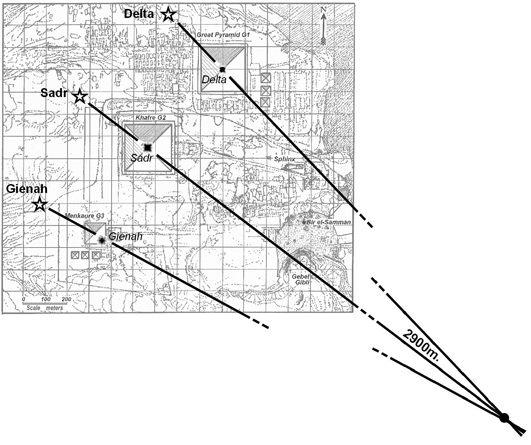
Cygnus
wing stars overlaid on the Giza Pyramids with the
corresponding horizontal
setting lines of the same
three stars as viewed from southeast of the plateau
(Picture
copyright: Andrew Collins/Rodney Hale 2009)
On
learning of this new match, the author checked survey measurements made during
his visit to Userkaf's sun-temple, hoping to find that the recorded azimuth bearings
of the Giza Pyramids would permit the three Cygnus wing stars to set down into
their respective pyramids as viewed from this spot during the Pyramid Age. Yet
Userkaf's sun-temple was located too far south of east for this to have happened
with any accuracy. An observation point where this might have occurred, visibility
permitting, would have to be at an azimuth much closer to southeast. This fact
aside, something did immediately become apparent. The projected line of sight
which would have enabled the witnessing of Cygnus's wing stars setting into their
respective pyramids was traceable much closer to the Giza plateau.
Having
scanned the local landscape, the author realized instantly where this was - Gebel
Gibli, Giza's southern hill. This seemed beyond coincidence.
Thus
a line was projected from the summit of Gebel Gibli through the center point of
the Second Pyramid, giving an azimuth bearing of approximately 307.5 degrees.
The author then ascertained the setting point of Sadr, the pyramid's corresponding
Cygnus star as viewed from Giza in 2550 BC, and found that this too was approximately
307.5 degrees, meaning that the star would have extinguished, i.e. set, into the
vertical center line of the Second Pyramid as viewed from Gebel Gibli during this
age. Remember, it was the star Sadr that represented the same pyramid in the Cygnus-Giza
overlay.
| More
revelations were to follow. If this Sadr setting line was followed away from the
plateau then at a position close to the enigmatic cemetery of Kafr el-Gebel, around
two kilometers southeast of the Second Pyramid, all three Cygnus wing stars would
have been seen setting into their corresponding pyramids. One amazing fact concerning the three Giza pyramids is that their apexes form a perfect arc, and if the center of this circle is traced it falls precisely on the Sadr setting line, close to the point where the three Cygnus wing stars set into their corresponding pyramids. Is this all simply coincidence? |
The tracks of the Cygnus wing stars as they set down into the three Giza Pyramids as seen in 2500 BC. The fourth track is that of Deneb, which does not feature in this multiple alignment(Picture copyright: Andrew Collins/Rodney Hale, 2009). |
This was extraordinary confirmation of Cygnus's role at Giza, and subsequent research carried out by Rodney Hale and the author uncovered a number of other major alignments featuring Gebel Gibli, Giza and Cygnus. Such findings made sense of ancient texts, as well as medieval Arabian sources that speak of each pyramid representing an individual star. In addition to this, it was found that as viewed from Gebel Gibli during the Pyramid Age, Cygnus's brightest star Deneb set down each night into the peak of the Second Pyramid.
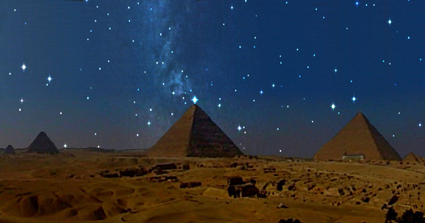
The bright star Deneb setting down into the apex of the Second Pyramid as viewed from the summit of Gebel Gibli during the Pyramid Age. Note the stream of stars forming the Milky Way trailing up into the sky from around the base of the same pyramid (Picture copyright: Andrew Collins/Rodney Hale, 2009).
On top of this was another curious fact. Inside the Great Pyramid is a bare room high within its solid stone interior known as the King's Chamber. It contains a large granite sarcophagus orientated north-south. For many years writers have speculated as to why the King's Chamber, which some believe once contained the mummy of King Khufu, is positioned south of the monument's vertical center line at an angle of just over 6 degrees. One quite incredible solution presents itself. In the Pyramid Age, the star Deneb culminated its nightly transit at 83.48 degrees, some 6.12 degrees north of Giza's zenith point, almost exactly in opposition to the King's Chamber's offset.
Anyone lying within the chamber's sarcophagus, with their head in the south and their feet to the north, could have symbolically gazed up through the apex of the Great Pyramid to witness Deneb crossing the meridian each night. Putting it another way, once each day Deneb synchronized perfectly with the apex of the Great Pyramid as viewed from the position of the sarcophagus in the King's Chamber. The fact that the two air-shafts in the north and south walls of the King's Chamber are thought to target the culmination of stars crossing the meridian makes this new Cygnus alignment totally viable. No other star crosses this same path during the Pyramid Age, making it a unique celestial phenomenon with profound implications to the concept of the soul's journey into an afterlife among the northern stars.
8.
PLACE OF THE BEGINNING
Many
of the alignments identified by Rodney Hale at Giza feature Gebel Gibli, which
was almost certainly the plateau's original survey point. Yet it is much more
than simply a convenient hill to be used for surveying purposes. It bears two
alternative names in Arabic - one being al-Hadbah, meaning the 'high place', a
name with religious connotations especially in Semitic religions. The other is
"Tarfaya", an ancient word meaning the 'first place', or the 'place
of beginnings', alluding to the hill's role as a primeval mound, from which all
else in the outside world took form. Among the geometry fixed on Gebel Gibli is
a north-south datum, or meridian, line that targets the Sphinx monument.
The
role played at Giza by Gebel Gibli and the well Bir es-Samman was becoming clearer,
but why exactly was Cygnus so important to the ancient Egyptian mindset, especially
at Giza? Would its role at Giza help us to uncover even more about the plateau's
chthonic domain?
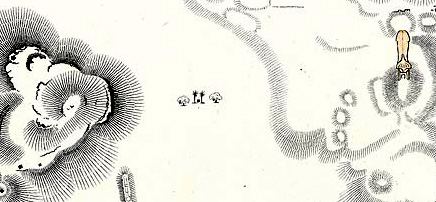
Section of the plan of the Giza plateau made by Karl Lepsius in 1842. Gebel Gibli is seen on the left, with the well Bir el-Samman in the center and the Sphinx on the right. The sycamore grove surrounding the well is sacred to Hathor, the mother of Horus the Elder.
9.
THE WOMB OF GOD
Cygnus's
role in ancient Egypt's sky religion remains controversial. Dr Ronald Wells, an
American astronomer working in the field of Egyptology, has argued that, due to
its prominent position where the Milky Way breaks in two to form the Cygnus Rift,
the Cygnus stars marked the position of the vulva or womb of the sky-goddess Nuit
in her role as the Milky Way. Dr Amanda-Alice Maravelia of the Center for Egyptian
Studies at the Russian Academy of Sciences (RAS), Moscow, has quite independently
affirmed the link between Cygnus, the Milky Way and the body of Nuit in a groundbreaking
paper entitled "Cosmic Space and Archetypal Time: Depictions Of The Sky-Goddess",
available in PDF format by clicking here.
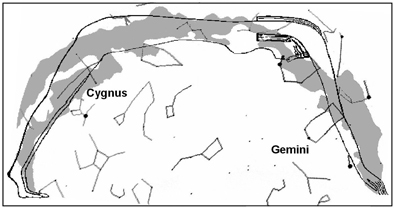
Nuit
personified as the Milky Way, with her womb and vulva marked by the stars of Cygnus
and the so-called Cygnus Rift (Picture copyright: Andrew Collins/Rodney Hale 2009).
In
ancient Egyptian Pyramid Texts the tomb, sarcophagus and coffin of the pharaoh,
in his role as Osiris, is equated with the womb of his mother Nuit. Other funerary
texts see her body as the tunnel-like Duat, through which the soul of the deceased
passes in its role as the sun-god Re. According to Mark Lehner, the soul in its
role as the new sun is reignited as it passes through the Fifth Hour of the night.
As previously noted, the Fifth Hour of the Duat is named as both the kingdom of
Sokar and Rostau, the ancient name for Giza. Thus we can say that the womb of
the sky-goddess Nuit, reflected in the sky as the constellation of Cygnus, was
associated with Giza's role as the Duat of Memphis. It thus makes sense that the
Pyramids of Giza reflected the astronomical positions of principal Cygnus stars,
for they were meant to harmonize with the celestial influences associated with
the womb of Nuit as the place of rebirth of the soul of the pharaoh when in the
Shetayet, or Tomb of Sokar-Osiris. Only by embracing this starry resonance could
the pharaoh, as the son of Nuit, achieve transformation into an akh, or
glorious spirit, at one with the stars of the northern sky.
10. TOMB OF THE BIRDS
In
May 2005, when we were introduced to the mysteries of the well Bir es-Samman for
the first time, my wife Sue and I also visited the site where the star Deneb fell
on the plateau's ground-sky overlay. Nothing of any obvious value could be discerned,
prompting the question of why this area west of the Great Pyramid might be important.
Investigating the area in question, the author explored a previously overlooked tomb, seemingly used in dynastic times as a bird necropolis (see the new books for further details). Most likely is that the site was associated with a local bird cult, either that of the falcon god Horus, son of Hathor, or, more plausibly, that of Sokar, the patron of the Memphis necropolis, and the guardian of the Duat of Giza-Memphis in the Am-duat text.
Only after I visited what we came to refer to as the "Tomb of the Birds" in January 2007 did I come to realize that it conformed to some quite profound landscape geometry determined in association with the Giza pyramid field by Rodney Hale. More incredibly, the author's colleague, the Egyptological researcher Nigel Skinner-Simpson, discovered that in 1817 Egypt's British Consul General Henry Salt, working alongside the famous Italian explorer Giovanni Caviglia, had visited the same area of the plateau and gained access to "Catacombs" that led into deep caves. These were explored for a distance of "several hundred yards" before the two men entered a large chamber that connected with three others of equal size, from which led many "labyrinthick" passages.
After carefully retracing Salt and Caviglia's explorations on the plateau, Nigel Skinner-Simpson came to realize that the entrance to Salt and Caviglia's Catacombs was in the vicinity of the Tomb of the Birds. Indeed, when he mentioned this to me I became convinced that it had to be the tomb itself.
The fact that Salt and Caviglia had explored Giza's catacombs for a distance of several hundred yards before giving up implied that if these presumably natural caves followed the natural contours of the plateau's underlying geology, then it meant that they could easily link up with a whole labyrinthine network of cave tunnels that existed beneath the main pyramids field, before disappearing beneath Gebel Gibli. These in turn would link with underground waterways, one of which carries water to the well Bir es-Samman, another possible entrance to Giza's hidden realm.
Was the Tomb of the Birds really the true Rostau, the "mouth of the passages", as well as the western entrance to the Duat of Memphis?
I
now became determined to get back there as soon as possible and search for answers.
Thus I sought sponsorship from the Association of Research of Enlightenment (ARE),
the active wing of the Edgar Cayce Foundation, the organization dedicated to confirming
the reality of its founder's predictions for the past 70 years. Suitably impressed
by the author's proposals, they agreed to support a preliminary exploration of
the Tomb of the Birds.
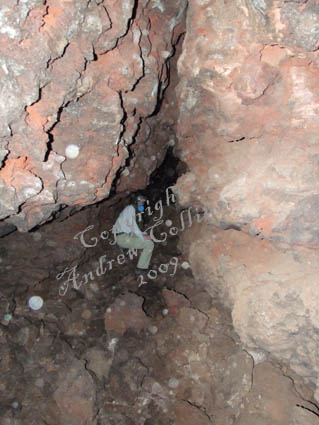
Sue Collins inside Giza's cave underworld (Picture copyright, Andrew Collins 2009).
What we discovered, and how it relates to the search for the Hall of Records, the Underworld of the Soul and the Shetayet of Sokar-Osiris is revealed for the first time in Beneath the Pyramids. It is an incredible journey, and one that I want you to join me in experiencing as we uncover the final truth behind the existence at Giza of an underground realm with a womb-like chamber of first creation reflecting the influence of Cygnus, the visible sign in the night sky of the celestial Shetayet, the womb of the cosmic mother personified as the Milky Way.
To read even more about the finding of Egypt's cave underworld, click here.
To
buy BENEATH THE PYRAMIDS, Andrew's new book on the quest to find Giza's cave underworld,
from Amazon click here.
To
buy straight from the publisher, 4th Dimension Press, click here.
Secure
BENEATH THE PYRAMIDS signed, direct from the author by clicking here